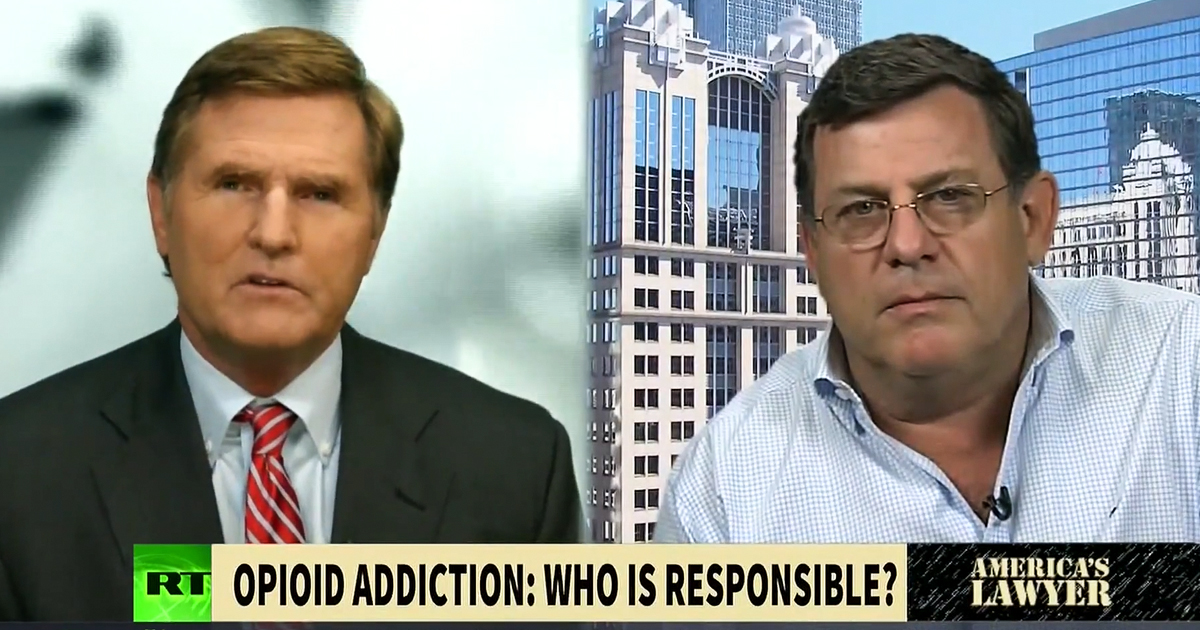Learn more about stories like this: AL.Law
The Attorney General of Illinois says a drug company pushed doctors to prescribe its opioid drug beyond its intended use, fueling the ongoing opioid epidemic. Mike Papantonio, host of America’s Lawyer, discusses this with Dr. John Benedetto, C.O.O. of Brightside, an opioid treatment clinic.
Transcript of the above video:
Mike Papantonio: A drug company in Arizona will possibly spend up to $4.5 million to settle a lawsuit brought against it by the attorney general of Illinois. The state attorney alleges that the company pushed doctors to prescribe its opioid pain killer beyond its intended use. According to Illinois’s Department of Public Health, nearly 1,400 residents have already died of overdoses from all types of opioids in 2015 alone. Joining me now to discuss the overall opioid addiction issue, from Illinois, is Dr. John Benedetto, COO of Brightside an opioid treatment clinic. As someone who works directly with opioid patients, what is the positive effect, do you think, that this settlement will have as far as Chicago in general? What do you think is the net of this, doc? What is your take?
Dr. Benedetto: Well, at Brightside we treat patients on the frontline, so these people are in crisis. We’re the first ones to see them, so it’s one of those things where, if they’re in crisis and we can’t see them right away, they don’t get seen at all. We have them treat them with immediacy and compassion. This type of settlement won’t help us at all. None of the money will find its way to the frontlines.
Mike Papantonio: Yeah, I think that’s a good point. As a matter of fact, as you may or may not have known before you came on this show, but we’re being hired to handle cases all over the country for various governments, but what we’re handling county by county, where the county can get money back for what it’s actually going to take to rehab for what it takes for dependency hearings, for what it takes for the law enforcement issues, all of this, what we call the tail of the epidemic. I’m sure you’re familiar with that term, is after the opioids come through, then comes the black tar heroin, and all types of drugs connected to it. I don’t see how this little bit of money really solves anything. How bad is the epidemic in Chicago?
Dr. Benedetto: It’s definitely way worse than the statistics, because the statistics are really run off of overdoses, and overdoses are just the tip of the iceberg. That has nothing to do with the actual number of people that are addicted. The crisis is actually exponentially bigger than what people are talking about.
Mike Papantonio: You’re seeing this firsthand, and as somebody seeing firsthand, you come out and say the statistics don’t mean anything, which I would totally agree with you. I’ve seen the statistics and I’ve talked to people like yourself who have to figure out, how do you treat these people to actually have any kind of meaningful result? Let me ask you this. The sum of the literature that I’m seeing is the opioid affects the dopamine control for the brain, and once that dopamine control is out of whack because of opioid addiction or heroin addiction, whichever may be, that it takes two to three years for the dopamine level just to come back to anything that looks like normal. How do you possibly treat this many people in a long-term for that little bit of money? I can’t understand why this attorney general settled this for so little money. That’s what I’m trying to get my head around.
Dr. Benedetto: Well, probably because it’s not really the pharmaceutical company’s fault. They’re supplying a medication that’s being misused at the doctor level and at that insurance level with the way that they rate pain control in the hospitals. They link their payments to the actual pain control surveys that they do. Doctors are incentivized to give too much medicine, otherwise they don’t get paid the same amount. They get paid less. This is a problem that’s bureaucratic in nature and has flowed all the way down to the private sector.
Mike Papantonio: Well, I would disagree with you on one thing, because I’m actually seeing the documents. You may not have that advantage. We’re seeing the documents where we see that the companies, the manufacturers and the distributors, actually built in what we call diversion, which is a criminal use. They actually built that into their business plan. You many not have heard that before.
If you look at the way the companies made money, the first two years they come out and say, “Well, gee whiz, we didn’t know this was going to happen.” By year three, four, five, six, and seven, it’s very clear that the distributors, that the salespeople living in neighborhoods where people are lined up around pill mills … It’s 7:00 in the morning in their pajamas waiting to get the pills. The actual salespeople are observing that going on. I don’t know how you could say it’s not because of the companies. We’re saying it’s absolutely because of the companies, it’s absolutely because of the distributors. Their [inaudible 00:04:41] profits, by the way, went from $158 million in year one to $6 billion in year four, so they knew what was going on and they actually built it in their business plan. Have you not seen signs of that in Chicago?
Dr. Benedetto: Well, I’ve seen massive amounts of that, especially in the early 90s, when Purdue Pharma was specifically doing that and teaching the doctors outright that the addiction level’s only 1% as long as you’re giving it for pain control. I wasn’t aware of that being done with other companies. It might very well be true. As far as I’m concerned, that may be the leading edge of it, but the real problem is the doctors prescribing, and they’re not prescribing properly.
Mike Papantonio: Well, are you familiar with the literature that Purdue and some of the manufacturers actually paid for and created, where they would send salespeople around to the doctors and say, “Gee whiz, we’ve done the studies and the studies show that this is not addictive.” They’re actually telling the doctors that, “Our opioid is different, so it’s okay for you to use it.” You know that part of the story too. We’re seeing more and more of that. We actually see the doctors that they hired to do this were paid to write these articles to phony up the truth about opioids being non-addictive. I don’t know if you’ve seen any of that in Chicago, but we see it all over the country.
Dr. Benedetto: Well, we’ve seen it, but particularly before with Purdue we saw it. With the modern companies, since that lawsuit has gone through, I wasn’t aware of any of these new ones doing that. I thought it was pretty much in the 90s with Purdue.
Mike Papantonio: Yeah, what we see, sir, is pictures, where law enforcement has taken pictures, of people standing in their pajamas lined up outside doctors’ offices, lined upside drugstores, lined outside pill mills. We find out that the distributor for that product lives no less than two miles away, drives by that every day, and sees that actually occurring. To say that there’s no notice, that the company didn’t know this was going on, that this is all the doctors’ fault, I just don’t see that connection, but maybe there’s something I’m missing. At full disclosure-
Dr. Benedetto: You still need-
Mike Papantonio: We’re hired to handle these cases on behalf counties and cities all over the country.
Dr. Benedetto: Right, but you still need doctors to write those prescriptions.
Mike Papantonio: I do appreciate your effort, and I don’t know how $4 million is going to be enough to go around here. At any rate, good luck up there. I hope you can help solve the problem. It’s going to take a lot more than $4 million. I think you’d agree with that.
Dr. Benedetto: No, I agree.
Mike Papantonio: Thanks for joining me.



